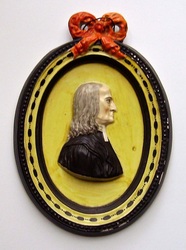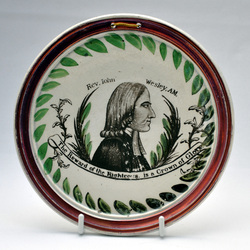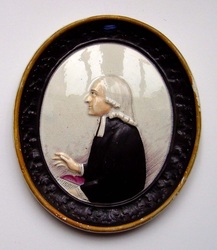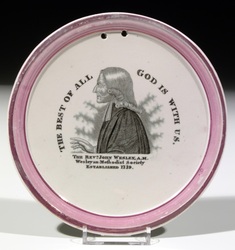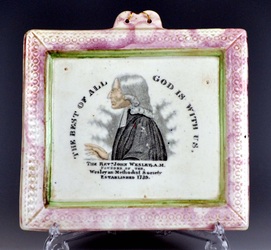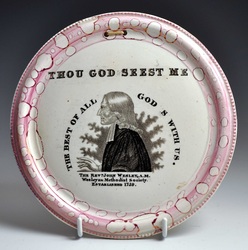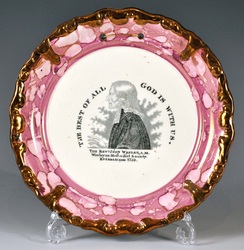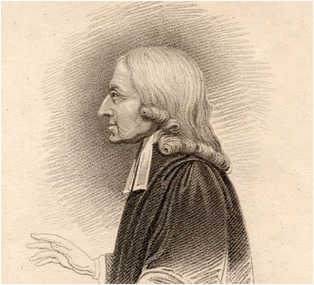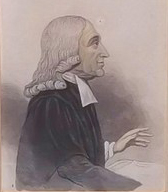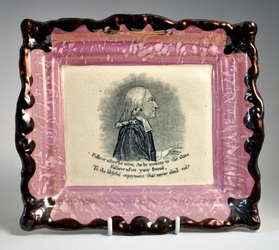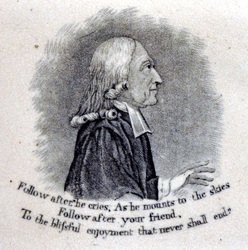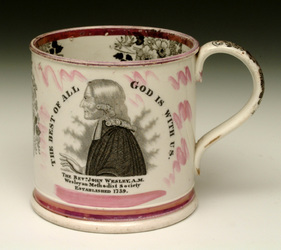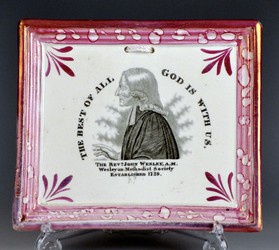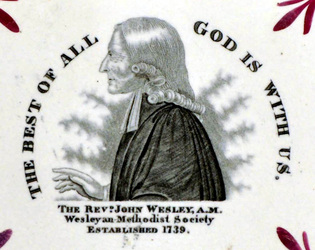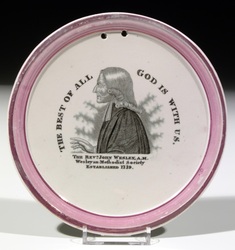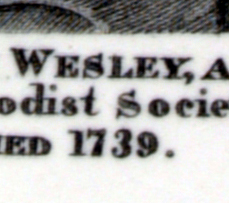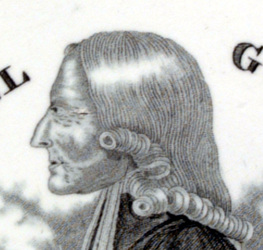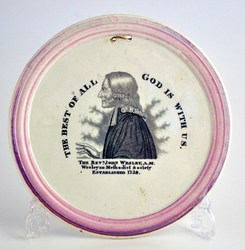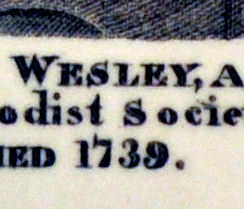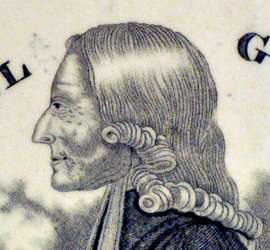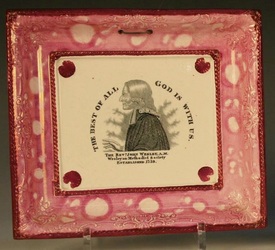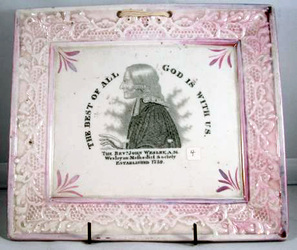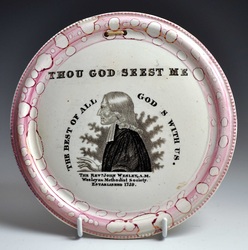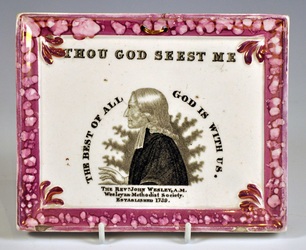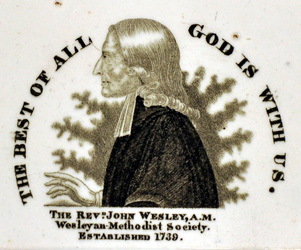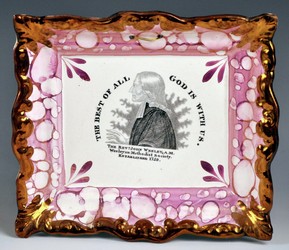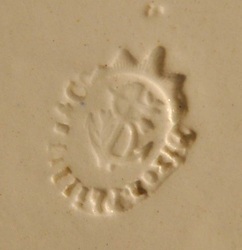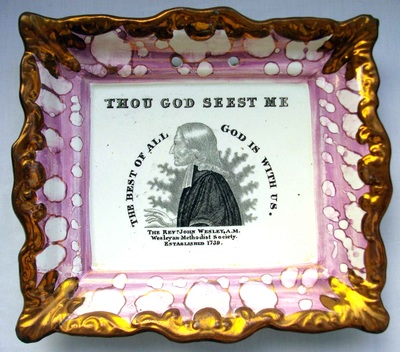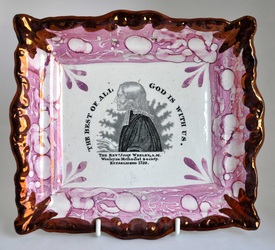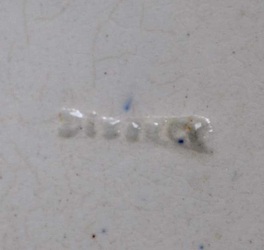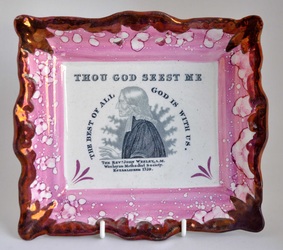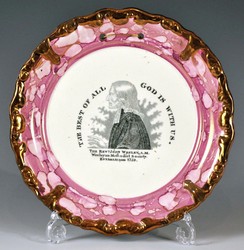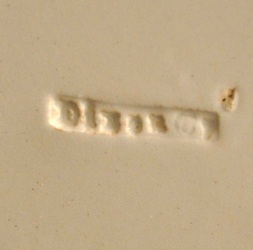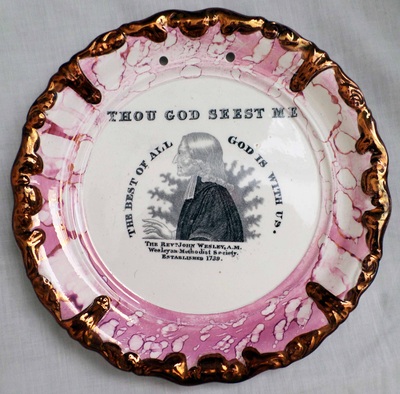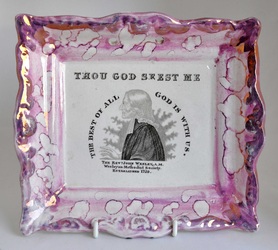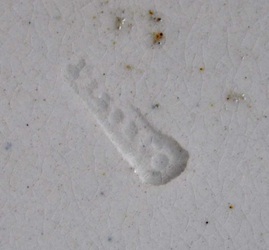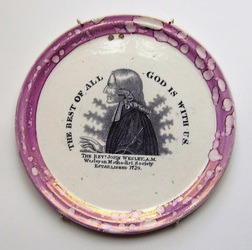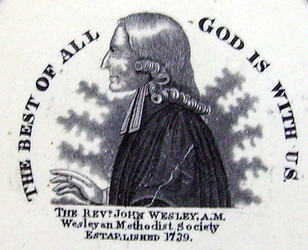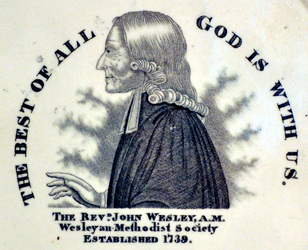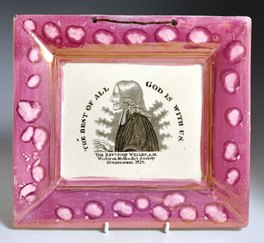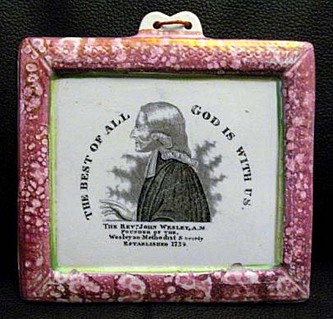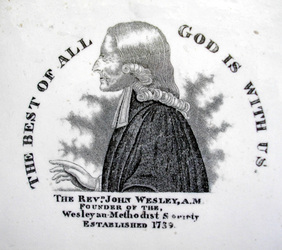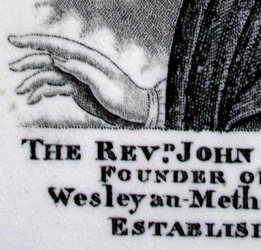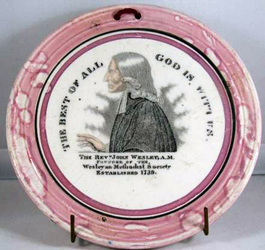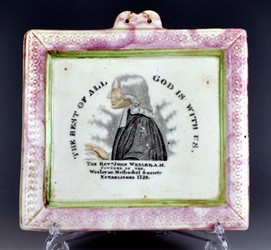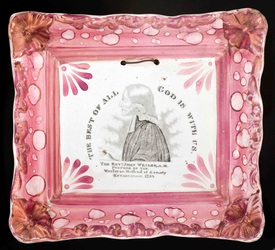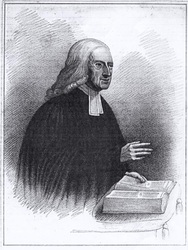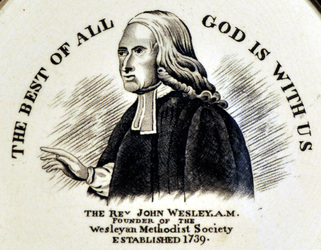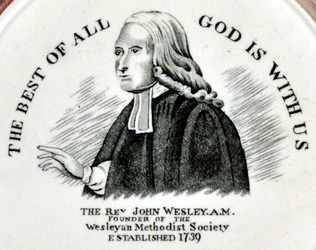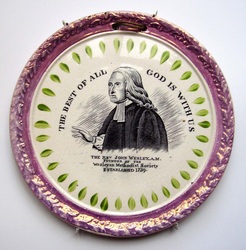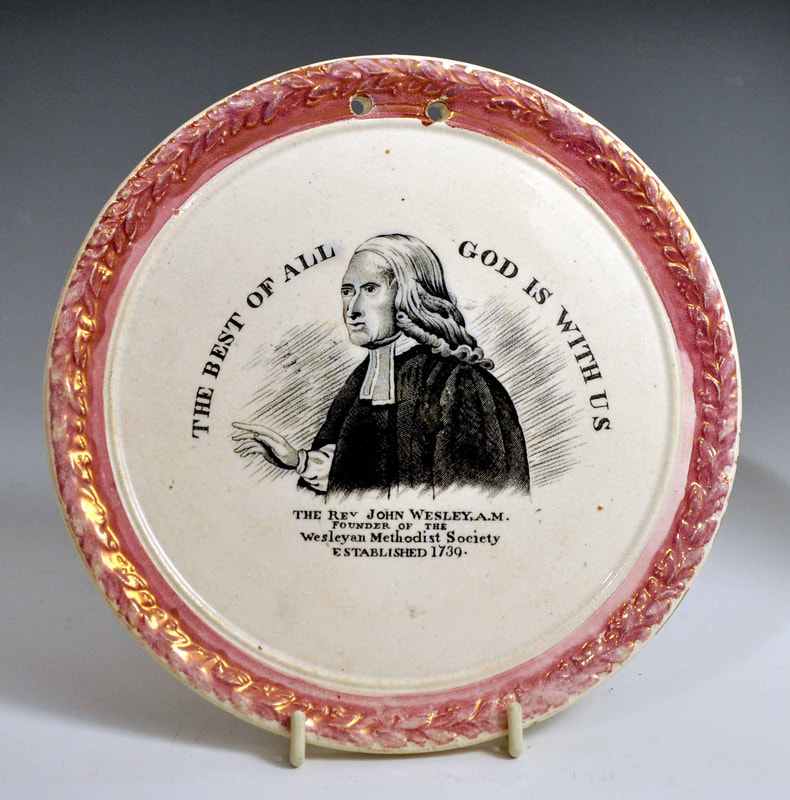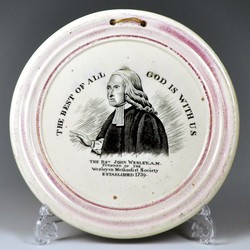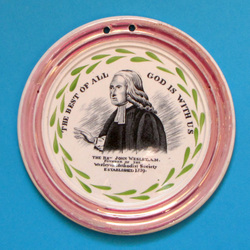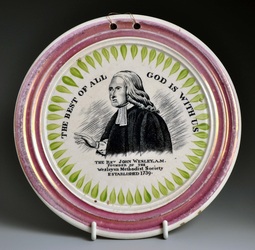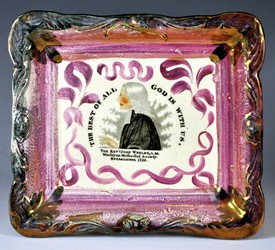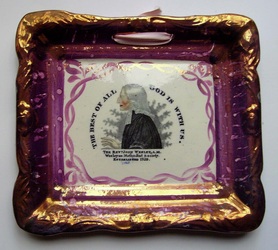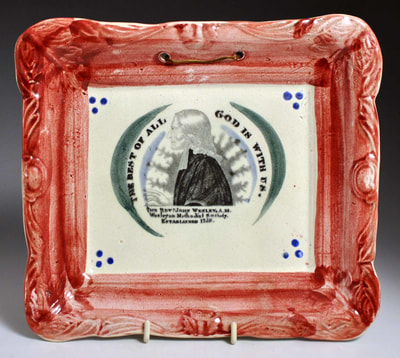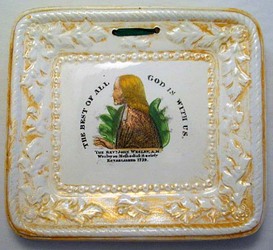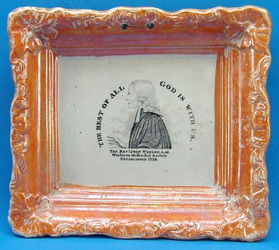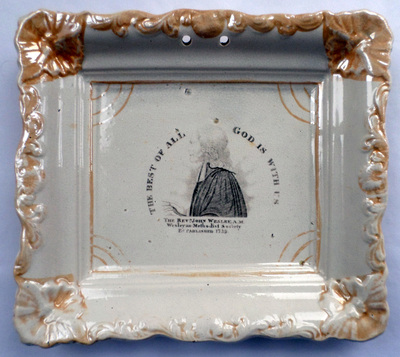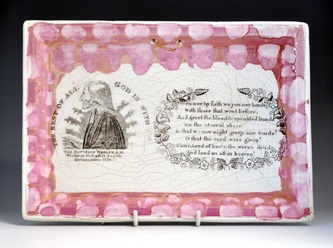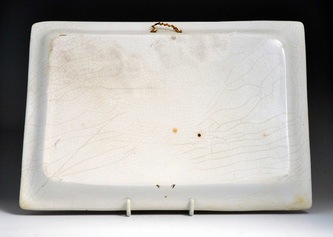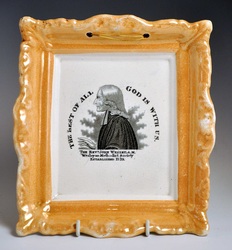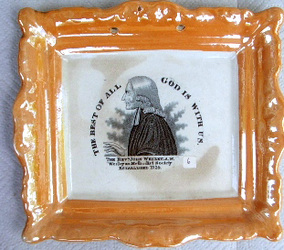For an overview of pink lustre plaques with religious subjects, click on the religious heading above.
John Wesley plaques
The earliest plaques with Wesley, like the relief plaque on the left above, were made c1791, the year of his death. The other relief plaque, above right, has a date of 1811 inscribed on the reverse. The centre plaque is possibly the earliest transfer-printed plaque of John Wesley. It has the impressed 'MALING' mark, and was made sometime after 1817, when the Maling Pottery moved to Newcastle. Nearly all the other Wesley transfers below pair with Adam Clarke, and were made after Clarke's death in 1832.
This page lists the Wesley transfers that appear on pink lustre plaques. See the Relief plaques page for further early examples. See the Dixon, Austin & Co, Staffordshire, Sheriff Hill and Tyneside pages for black & white and other coloured plaques with Wesley transfers.
This page lists the Wesley transfers that appear on pink lustre plaques. See the Relief plaques page for further early examples. See the Dixon, Austin & Co, Staffordshire, Sheriff Hill and Tyneside pages for black & white and other coloured plaques with Wesley transfers.
The most common transfers of John Wesley (see many examples on this page) are based on the above portrait by Henry Edridge (1769–1821) done in 1790, the year before Wesley died.
A print made after the portrait is the basis for one of the rarest Wesley transfers to appear on plaques (see above). This plaque doesn't have an Adam Clarke to pair, but was likely made c1840.
Attributed to Scott of Southwick (plate 1), Sunderland
These unmarked plaques are attributed to Scott of Southwick on the basis that the Wesley and Clarke transfers, and the Charles Wesley verses which appear on them, also appear on typical Scott items (see top left). Unlike the Edridge portrait on which they are based, the images of Wesley on plaques tend to be surrounded by an 'aura' – a kind of divine force field radiating out from Wesley in prongs. The 'Scott' Wesley transfers have 5 prongs to the right. The words 'FOUNDER OF THE' do not appear in the title. The Scott transfers are very similar to the C, C & Co transfer.
There are two versions of the 'Scott' Wesley transfer, so similar as to be almost indistinguishable. I've labelled them plate 1 and plate 2. Take a look at the Scott page for photos of the copper transfer plates, which unusually have survived, and a detailed comparison of the two versions. On plate 1 there is no scratch over the letter 'i' in society (see centre detail). Wesley's pupil is smaller (see right detail) and there are more wrinkles to the right of his eye.
There are two versions of the 'Scott' Wesley transfer, so similar as to be almost indistinguishable. I've labelled them plate 1 and plate 2. Take a look at the Scott page for photos of the copper transfer plates, which unusually have survived, and a detailed comparison of the two versions. On plate 1 there is no scratch over the letter 'i' in society (see centre detail). Wesley's pupil is smaller (see right detail) and there are more wrinkles to the right of his eye.
Attributed to Scott of Southwick (plate 2), Sunderland
See the notes on plate 1 above. On plate 2 there is a small scratch over the letter 'i' in society (see centre detail). The first letter 'E' in 'WESLEY' is scrunched up at the top. Wesley's pupil is larger (see right detail) and there are fewer wrinkles to the right of his eye. The two versions of the transfer appear to have been used interchangeably on the same plaque forms.
Dixon, Austin & Co, and Dixon, Phillips & Co, Garrison Pottery, Sunderland
The unmarked plaques above are attributed to the Garrison Pottery, and were likely made under the Dixon, Austin & Co partnership, sometime between 1832 and 1839. Similar plaques continued to be made into the 1840s, and at least one rectangular example (a Prepare to Meet Thy God) exists with the 'Dixon, Phillips & Co' (surrounding anchor) mark. See the Dixon plaques page for black and yellow examples.
The 'Dixon' Wesley is easily distinguishable from the other Wesley transfers based on the Edridge portrait. The defining feature of the Dixon transfer (above right) is that to the right of Wesley there are 6 prongs, whereas on other Wesley transfers there are only 5 prongs, e.g. the Scott transfer. The Dixon transfer, unlike the others, has a full stop after the word 'Society'. The words 'FOUNDER OF THE' do not appear in the title.
The circular plaques above, and the more common rectangular variety, can be found with the 'Dixon, Phillips & Co' (surrounding anchor) and the 'Dixon Co' impressed mark. Plaques exist with and without the 'THOU GOD SEEST ME' banner, for both impressed marks. In each case above, the impressed mark is on the reverse of the plaque shown to its left. The Dixon, Phillips & Co anchor mark appears to have been used from 1839–c1850. Whereas the Dixon Co impressed mark, was likely used from c1851 until the Garrison Pottery closed in 1865. The last plaque above, with pink rather than copper lustre edges, is likely from the final years of the pottery's production.
Attributed to C, C & Co, North Shields
Although the plaque above has no impressed mark, the colour, quality and application of the lustre are very similar to plaques with the C, C & Co impress. Like marked C, C & Co plaques, it is 167mm in diameter. Compare the 'C, C & Co' transfer (centre) with the 'Scott' transfer (right). It is distinguishable from its Scott counterpart in that the 'aura' around Wesley is more bobbly – almost like Brussels sprouts on a stalk. The lettering in the title on the 'C, C & Co' transfer has longer, more elegant, serifs (click on the details to enlarge and to move between them). The transfer also appears on a rare plaque form attributed to John Carr (see below).
Attributed to Sheriff Hill and Thomas Fell
I've never seen a plaque with a Sheriff Hill Pottery impressed mark. The attribution stems from two child's plates (see the Sheriff Hill page) with the impressed mark 'J.&P' for Jackson and Patterson of the Sheriff Hill Pottery. The Wesley transfer shared by those plates and the plaques above is easily identifiable. It shows the Henry Edridge portrait with an extra line, 'FOUNDER OF THE', in the title. The transfer has a couple of tiny flaws. The top right of the letter 'N' in the word 'JOHN' is in-filled (see top right detail). Note also the heavy left foot of the letter 'M' in 'Methodist'. See the Sheriff Hill page for many black and yellow examples.
The copper transfer plate, along with others from Sheriff Hill, appears to have moved to Fell c1845. The plaque bottom right above (the image is credited to The Royal Pavilion and Museums, Brighton & Hove image store) has hanging holes below the lustre border, typical of Fell. N.B. Maling also used this plaque form, but with hanging holes pierced through the lustre border.
The copper transfer plate, along with others from Sheriff Hill, appears to have moved to Fell c1845. The plaque bottom right above (the image is credited to The Royal Pavilion and Museums, Brighton & Hove image store) has hanging holes below the lustre border, typical of Fell. N.B. Maling also used this plaque form, but with hanging holes pierced through the lustre border.
Attributed to Fell or Carr & Patton
See this page for details of the attribution. This transfer of John Wesley is in the manner of an etching by William Thomas Fry (1789–1843) of a portrait of Wesley by John Renton (c1774–1841) (see above). This version (centre above) has a diagonally hatched background with a unique flaw. Imagine Wesley is holding a cigarette between his fingers, and a white smoke ring is drifting from its end, which you can faintly make out against the hatched background. On the Maling version, there is a full stop after the date '1739'. A similar variation of the transfer appears on plaques from an unidentified pottery, presumably also Tyneside (see right above). The hatched background has no smoke ring, and there's no full stop after the date. Click here for other Tyneside examples.
Attributed to John Carr, Low Lights Pottery, North Shields
The plaques above have the Dixon transfer, but are attributed to John Carr's Low Lights Pottery in North Shields. It seems likely, therefore, that they post date 1865 when the Garrison Pottery (Dixon & partners) closed. The copper transfer plates were sold to other potteries in that year. The transfer plate looks to have been re-engraved to improve clarity.
Later plaques
The orange plaques above have 'Scott' Wesley transfers. The first plaque form is associated with Scott, and the second with Moore. However, the poor execution of the plaques and weak imprints suggest they are late. They were probably produced after the moulds and transfer plates had moved to Ball's Deptford Pottery, post 1897. The large and very rare plaque form below (10.5 x 7.25 inches) has the 'Scott' Wesley printed next to a Charles Wesley verse. It was also likely made by Ball Bros.
The plaques below, from an unknown pottery, have yet another variation of the Edridge portrait. The 'bobbly aura' is similar to the C,C & Co transfer. Note that the transfer appears on both portrait and landscape oriented plaques.
